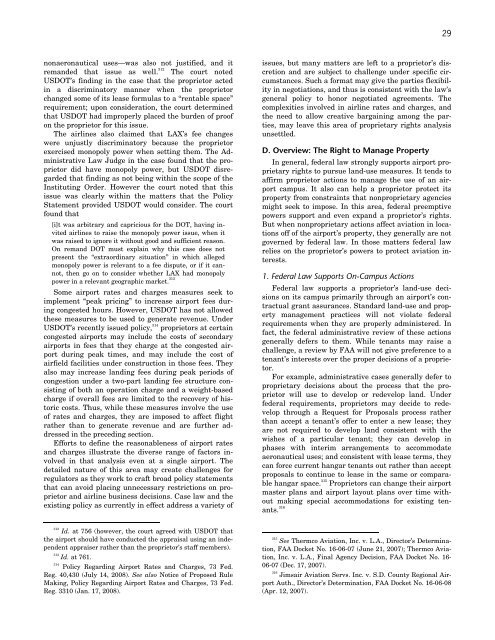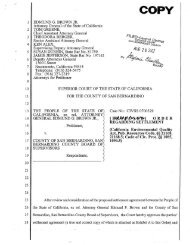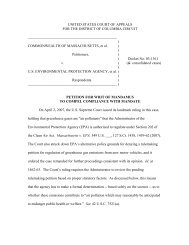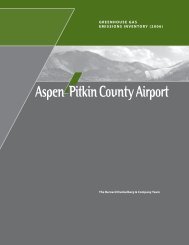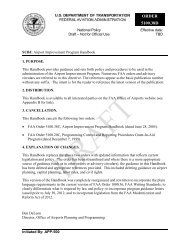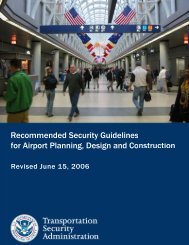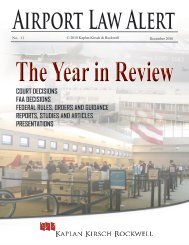ACRP Legal Research Digest 10
ACRP Legal Research Digest 10
ACRP Legal Research Digest 10
Create successful ePaper yourself
Turn your PDF publications into a flip-book with our unique Google optimized e-Paper software.
29<br />
nonaeronautical uses—was also not justified, and it<br />
remanded that issue as well. 312<br />
The court noted<br />
USDOT’s finding in the case that the proprietor acted<br />
in a discriminatory manner when the proprietor<br />
changed some of its lease formulas to a “rentable space”<br />
requirement; upon consideration, the court determined<br />
that USDOT had improperly placed the burden of proof<br />
on the proprietor for this issue.<br />
The airlines also claimed that LAX’s fee changes<br />
were unjustly discriminatory because the proprietor<br />
exercised monopoly power when setting them. The Administrative<br />
Law Judge in the case found that the proprietor<br />
did have monopoly power, but USDOT disregarded<br />
that finding as not being within the scope of the<br />
Instituting Order. However the court noted that this<br />
issue was clearly within the matters that the Policy<br />
Statement provided USDOT would consider. The court<br />
found that<br />
[i]t was arbitrary and capricious for the DOT, having invited<br />
airlines to raise the monopoly power issue, when it<br />
was raised to ignore it without good and sufficient reason.<br />
On remand DOT must explain why this case does not<br />
present the “extraordinary situation” in which alleged<br />
monopoly power is relevant to a fee dispute, or if it cannot,<br />
then go on to consider whether LAX had monopoly<br />
power in a relevant geographic market. 313<br />
Some airport rates and charges measures seek to<br />
implement “peak pricing” to increase airport fees during<br />
congested hours. However, USDOT has not allowed<br />
these measures to be used to generate revenue. Under<br />
USDOT’s recently issued policy, 314 proprietors at certain<br />
congested airports may include the costs of secondary<br />
airports in fees that they charge at the congested airport<br />
during peak times, and may include the cost of<br />
airfield facilities under construction in those fees. They<br />
also may increase landing fees during peak periods of<br />
congestion under a two-part landing fee structure consisting<br />
of both an operation charge and a weight-based<br />
charge if overall fees are limited to the recovery of historic<br />
costs. Thus, while these measures involve the use<br />
of rates and charges, they are imposed to affect flight<br />
rather than to generate revenue and are further addressed<br />
in the preceding section.<br />
Efforts to define the reasonableness of airport rates<br />
and charges illustrate the diverse range of factors involved<br />
in that analysis even at a single airport. The<br />
detailed nature of this area may create challenges for<br />
regulators as they work to craft broad policy statements<br />
that can avoid placing unnecessary restrictions on proprietor<br />
and airline business decisions. Case law and the<br />
existing policy as currently in effect address a variety of<br />
issues, but many matters are left to a proprietor’s discretion<br />
and are subject to challenge under specific circumstances.<br />
Such a format may give the parties flexibility<br />
in negotiations, and thus is consistent with the law’s<br />
general policy to honor negotiated agreements. The<br />
complexities involved in airline rates and charges, and<br />
the need to allow creative bargaining among the parties,<br />
may leave this area of proprietary rights analysis<br />
unsettled.<br />
D. Overview: The Right to Manage Property<br />
In general, federal law strongly supports airport proprietary<br />
rights to pursue land-use measures. It tends to<br />
affirm proprietor actions to manage the use of an airport<br />
campus. It also can help a proprietor protect its<br />
property from constraints that nonproprietary agencies<br />
might seek to impose. In this area, federal preemptive<br />
powers support and even expand a proprietor’s rights.<br />
But when nonproprietary actions affect aviation in locations<br />
off of the airport’s property, they generally are not<br />
governed by federal law. In those matters federal law<br />
relies on the proprietor’s powers to protect aviation interests.<br />
1. Federal Law Supports On-Campus Actions<br />
Federal law supports a proprietor’s land-use decisions<br />
on its campus primarily through an airport’s contractual<br />
grant assurances. Standard land-use and property<br />
management practices will not violate federal<br />
requirements when they are properly administered. In<br />
fact, the federal administrative review of these actions<br />
generally defers to them. While tenants may raise a<br />
challenge, a review by FAA will not give preference to a<br />
tenant’s interests over the proper decisions of a proprietor.<br />
For example, administrative cases generally defer to<br />
proprietary decisions about the process that the proprietor<br />
will use to develop or redevelop land. Under<br />
federal requirements, proprietors may decide to redevelop<br />
through a Request for Proposals process rather<br />
than accept a tenant’s offer to enter a new lease; they<br />
are not required to develop land consistent with the<br />
wishes of a particular tenant; they can develop in<br />
phases with interim arrangements to accommodate<br />
aeronautical uses; and consistent with lease terms, they<br />
can force current hangar tenants out rather than accept<br />
proposals to continue to lease in the same or comparable<br />
hangar space. 315 Proprietors can change their airport<br />
master plans and airport layout plans over time without<br />
making special accommodations for existing tenants.<br />
316<br />
312<br />
Id. at 756 (however, the court agreed with USDOT that<br />
the airport should have conducted the appraisal using an independent<br />
appraiser rather than the proprietor’s staff members).<br />
313<br />
Id. at 761.<br />
314<br />
Policy Regarding Airport Rates and Charges, 73 Fed.<br />
Reg. 40,430 (July 14, 2008). See also Notice of Proposed Rule<br />
Making, Policy Regarding Airport Rates and Charges, 73 Fed.<br />
Reg. 33<strong>10</strong> (Jan. 17, 2008).<br />
315 See Thermco Aviation, Inc. v. L.A., Director’s Determination,<br />
FAA Docket No. 16-06-07 (June 21, 2007); Thermco Aviation,<br />
Inc. v. L.A., Final Agency Decision, FAA Docket No. 16-<br />
06-07 (Dec. 17, 2007).<br />
316<br />
Jimsair Aviation Servs. Inc. v. S.D. County Regional Airport<br />
Auth., Director’s Determination, FAA Docket No. 16-06-08<br />
(Apr. 12, 2007).


